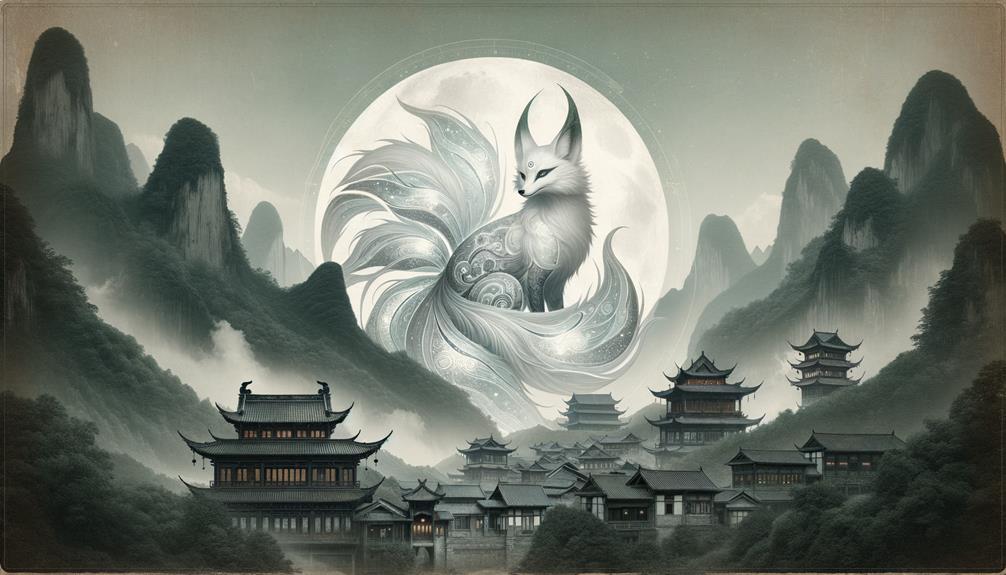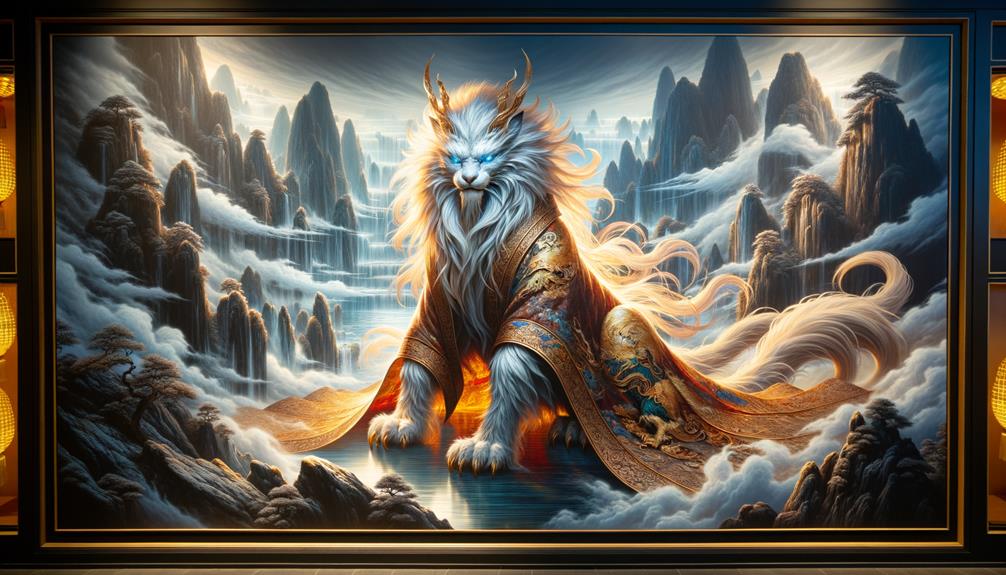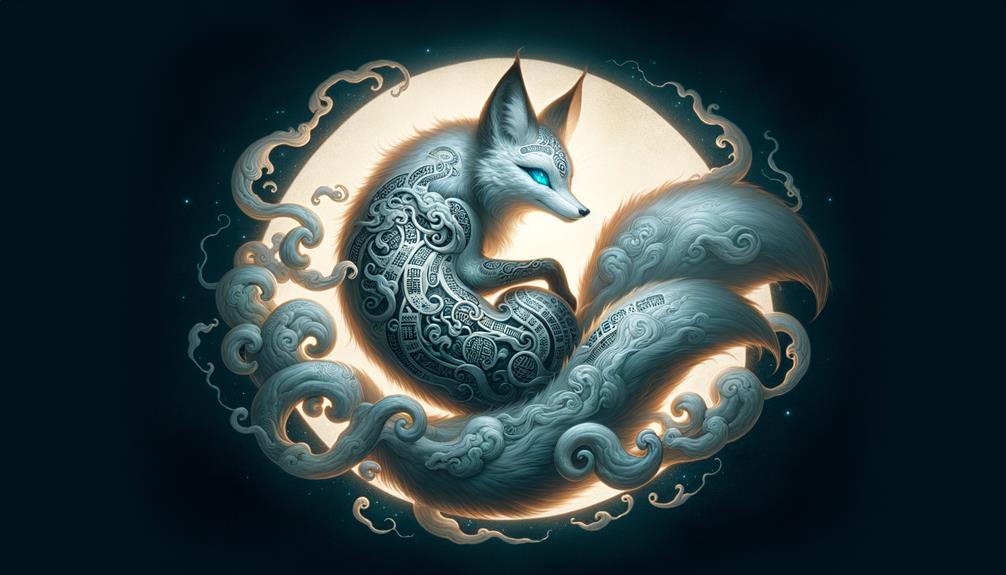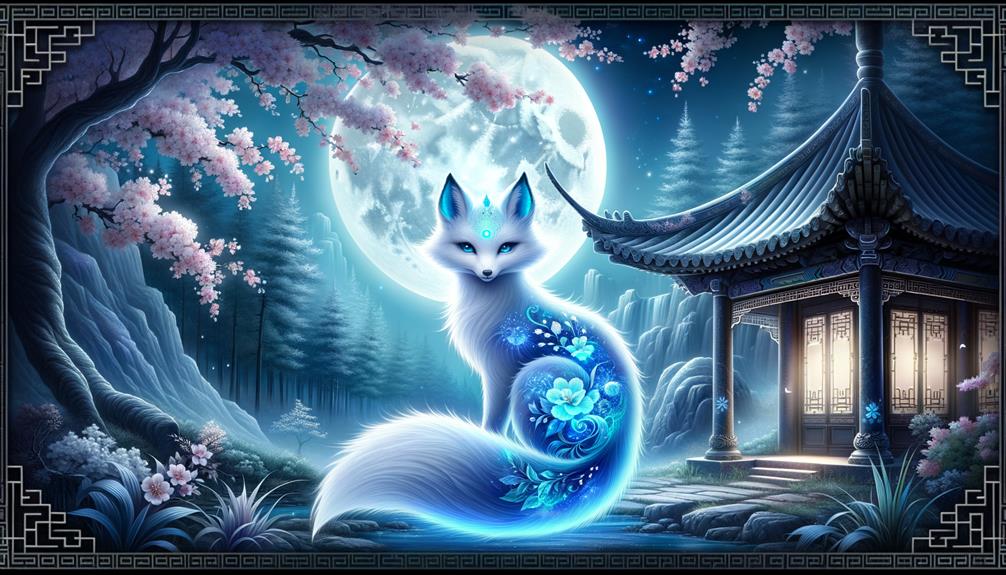Unveiling the Fascinating Lore of the Huli Jing: The Chinese Fox Spirit
For many, the Huli Jing or Chinese Fox Spirit might appear as a simple creation of folklore. However, a closer examination reveals that this captivating creature embodies deep-rooted beliefs within Chinese culture and spirituality.
The Enigma of the Shape-Shifting Seductress
Often portrayed as a shape-shifting seductress, the Huli Jing is more than a mythical figure. She reflects the intricate dynamics of Chinese perspectives on morality, femininity, and the supernatural. Through her transformations, she challenges traditional norms and invites contemplation on the relationship between humans and the spiritual realm.
Transmutation, Manipulation, and Communication: The Triad of Huli Jing’s Powers
The Huli Jing’s abilities to change form, manipulate natural elements, and communicate with both humans and animals add profound depth to her character. In various legends, she transforms into a beautiful woman to interact with people, often influencing events through her supernatural powers. Her command over nature and her role as a bridge between realms illustrate the richness of Chinese mythology.
For example, in classical stories collected in Strange Tales from a Chinese Studio by Pu Songling, fox spirits frequently appear, showcasing their transformative abilities and interactions with humans.
The Huli Jing’s Influence on Chinese Literature and Society
The Huli Jing has significantly impacted Chinese literature, art, and societal values. Her stories often serve as moral lessons, reflecting the complexities of human nature and the supernatural. The fox spirit embodies themes of love, deception, wisdom, and enlightenment, leaving an enduring legacy in Chinese cultural expressions.
As I see it, understanding the Huli Jing offers deep insights into the cultural and spiritual fabric of China.
A Look into Chinese Mythology
This exploration takes us into the heart of Chinese cultural beliefs. It’s not just about learning about a mythical creature; it’s about appreciating an entire civilization’s worldview. By studying the lore of the Huli Jing, we uncover perspectives on morality, spirituality, and the interplay between the human and the divine.
This journey is complemented by resources like the Encyclopedia Britannica’s article on Chinese mythology, which provides additional context and depth.
“In the tales of the Huli Jing, one finds not just stories of enchantment but reflections of the human soul seeking understanding in a world of mysteries.”
Final Thoughts
The Huli Jing is a compelling figure that encapsulates the essence of Chinese cultural and spiritual complexity. Studying her lore reveals an intriguing blend of morality, mystery, and mythology. Immersing oneself in Chinese folklore enhances our understanding of this fascinating creature and leads to a deeper appreciation of a culture that has shaped human history for millennia.
Understanding the Huli Jing Myth

Deciphering the Huli Jing: Understanding Chinese Fox Spirits
To truly comprehend the Huli Jing myth, it’s essential to examine her diverse portrayals as a nine-tailed fox endowed with potent magical capabilities. Her transformative powers, ability to communicate with animals, and command over natural elements have left lasting impressions on Chinese literature, art, and popular culture. The Huli Jing symbolizes both the allure and caution of the supernatural, embodying themes that have been significant throughout Chinese history.
Huli Jing: The Enchanting Fox Spirits of Chinese Mythology
Huli Jing, or fox spirits, hold a prominent position in Chinese mythology. They are often depicted as captivating young women, employing their extraordinary powers to conjure illusions and sway the human mind. These fox spirits, encountered in the annals of Chinese history, are objects of reverence and fear alike. They are seen as shrewd tricksters or bringers of fortune, embodying a fascinating duality.
Taking a leaf from Chinese mythology, the tale of Daji serves as an apt illustration of the huli jing’s presence in ancient texts. The fox spirit adopted the persona of a seductive woman, showcasing her dominance over the king and his court.
Symbolism of the Fox: Power and Deception
In symbolic terms, the fox is a testament to power. The multifaceted nature of the huli jing mirrors the complex interplay between humans and spirits. This duality underscores the thin line between deception and truth, good and evil. It stands as a powerful testament to the enduring fascination and respect for these mythical creatures within Chinese culture.
Engaging with the Huli Jing Myth: A Testament to Chinese Culture’s Richness
The Huli Jing myth is more than just a story; it’s a reflection of the profound relationship between humans and the supernatural in Chinese culture. Understanding these mystical fox spirits necessitates a deep dive into the myriad ways they interact with humans, manipulate elements, and shape Chinese art and literature. The huli jing’s multi-dimensional nature is a rich tapestry that invites exploration and provides a unique perspective on Chinese mythology.
Huli Jing in Chinese Folklore

Discovering the Huli Jing: A Deep Dive into Chinese Folklore
The Huli Jing, a captivating figure from Chinese mythology, is as complex as it is fascinating. This nine-tailed fox spirit is no mere fairy tale creature. In fact, it is an embodiment of the opposing forces of good and evil, a symbol of the intricate balance of yin and yang. Its ability to transform into a beautiful young human showcases its intelligence and underscores its multifaceted role in China’s cultural tapestry.
The Huli Jing: A Symbol of Transcendence
Known for absorbing masculine energy, the Huli Jing serves as a powerful symbol of the transcendence of yin and yang. Its transformative nature and dualistic character provide a rich insight into Chinese folklore, offering us a window into the values, fears, and aspirations of both ancient and modern China.
Worshipping the Fox Spirits: The Huli Jing in History
The Huli Jing’s popularity reached its peak during the Tang dynasty when these fox spirits were revered and worshipped. Even when they were later outlawed in the Song dynasty, their allure persisted. Their intriguing depictions in literature and modern culture continue to draw in audiences, proof of their lasting impact and cultural significance.
“However, make no mistake — the Huli Jing is not just a beautiful fox demon. It’s a symbol of the intricate dance between good and evil, a testament to the duality inherent in Chinese mythology.”
Understanding the Huli Jing: A Journey into Chinese Mythology
In exploring the Huli Jing, we delve deeper into the heart of Chinese folklore. By understanding its place and significance, we glean valuable insights into Chinese culture and the human condition. This exploration is not just a study of mythology but a journey into the wisdom of ancient civilizations.
In the realm of Chinese folklore, the Huli Jing stands as a testament to the country’s rich cultural fabric. Its complex nature and transformative abilities are a vivid portrayal of the duality inherent in life — a powerful reminder that good and evil are but two sides of the same coin.
The Shapeshifting Phenomenon

Unraveling the Enigma: The Shapeshifting Phenomenon of the Huli Jing
Peering into the mysterious sphere of shapeshifting phenomena, let’s explore the Huli Jing, a creature whose transformative prowess intensifies with time. This Chinese fox spirit, steeped in ancient mythology, has the intriguing ability to morph into various forms — from humans to other creatures. Often, tales depict this entity as a mesmerizing maiden, artfully using its transformative skills to beguile the human race. However, the true essence of this enigmatic creature extends far beyond its outward appearances.
- Benevolent Spirits: Exploding Myths Around Huli Jing
Contrary to the widespread notion, not every Huli Jing harbors malevolent intentions. Some indeed serve as benevolent spirits, channeling their transformative abilities towards noble deeds.
- Master of Disguise: The Shapeshifting Artistry of Fox Spirits
Their knack for appearing as young or old, or morphing into an entirely different species, forms a recurring motif in fox spirit stories. This versatility only serves to heighten their air of mystique and elusiveness.
- The Dark Side: Fox Demons as Cautionary Figures
Fox demons, a more sinister manifestation of Huli Jing, serve as cautionary figures in Chinese folklore. They harness the shapeshifting phenomenon for mischievous or harmful purposes.
- Ultimate Transformation: Ascension of Fox Spirits
Upon reaching the grand age of a millennium, a fox spirit can ascend to heaven — a testament to their ultimate transformation.
In essence, the Huli Jing’s shapeshifting abilities are far from mere parlor tricks. They are mirrors reflecting their intricate, multifaceted identities, encompassing both light and dark, mortal and divine.
This deeper understanding of Huli Jing’s transformative nature offers a fresh perspective on the shapeshifting phenomenon. It encourages us to view these creatures not as simple tricksters, but as complex beings with a rich tapestry of identities. With their captivating tales and intriguing abilities, the Huli Jing are sure to continue enthralling myth lovers and folklore enthusiasts for generations to come.
Huli Jing’s Good and Evil Aspects

Huli Jing: The Dualistic Fox of Chinese Mythology
Dive into the captivating world of Chinese mythology, and you’ll discover a complex character that embodies both a blessing and a curse: the Huli Jing. This intricate figure, also known as the Chinese fox spirit, symbolizes a fascinating duality of prosperity and disaster, reflecting the rich tapestry of Chinese culture.
The Huli Jing – A Paradox in Folklore
During the vibrant era of the Tang Dynasty, fox worship was a common practice. The celestial fox was revered as an embodiment of the Huli Jing, a testament to its significant cultural influence. These fox spirits weren’t just symbolic; they had the power to bestow wealth and fertility, illustrating their positive attributes. However, they could also bring about illness and demise, revealing their darker side.
These fox spirits were known for their cunning and deceptive traits, often possessing individuals with their sly nature. But they weren’t all about trickery. Alongside their subversive tendencies, they had a benevolent side, offering moral guidance and healing, thus demonstrating their multifaceted character.
The Enduring Allure of the Huli Jing
The Huli Jing’s dualistic nature is a recurring theme in various Chinese folklore, demonstrating its enduring allure in contemporary Chinese culture. They can play the role of mischievous tricksters causing chaos, or serve as wise guides imparting valuable lessons. This dichotomy continues to fascinate and intrigue, underlining their perpetual presence in Chinese mythology.
The Huli Jing (狐狸精 húlijīng) is more than just a mythical figure; it’s a dynamic symbol of Chinese culture, embodying paradoxes, complexities, and dualities. This unique blend of attributes makes the Huli Jing a truly captivating subject, and its essence continues to resonate in the cultural expressions of modern China.
As we delve deeper into the world of Chinese mythology, let’s keep the Huli Jing in mind. This Chinese fox spirit serves as a reminder of the richness, depth, and complexity that characterizes Chinese folklore. Whether you view them as tricksters or guides, their dualistic nature and enduring presence are sure to leave you enchanted.
Huli Jing’s Influence on Literature

Unearthing the Cultural Significance of Huli Jing in Literature
The fascinating dualistic nature and enduring presence of the Huli Jing, or fox spirit, is a captivating subject. However, it’s the fox spirit’s profound impact on Chinese literature that truly highlights its cultural significance.
The Huli Jing, a key figure in Chinese mythology, has played a catalytic role in countless stories and legends, from the Han dynasty right through to the Song dynasty. A prime example of the fox spirit’s influence is the notorious Daji, a nine-tailed creature embodying the allure and danger inherent in these beings. Daji’s saga, alongside others, has firmly established the fox spirit as a figure of depth, capable of both love and destruction.
Huli Jing’s Impact Beyond Chinese Borders
The Huli Jing’s literary influence isn’t limited to China; it has also infiltrated Japanese storytelling through the tales of the kitsune. Here’s a concise overview of the fox spirit’s literary impressions:
- It’s responsible for molding the depiction of fox spirits in Chinese mythology.
- It’s sparked love stories portraying intricate relationships between humans and fox spirits.
- It mirrors societal changes, as exemplified by the prohibition of fox spirit cults during the Song dynasty.
- It has become a topic of scholarly exploration in literature.
The Enduring Influence of Huli Jing
This influence, spanning centuries, underlines the Huli Jing’s cultural importance and its pivotal role in Chinese literature. This engaging topic, rich with real-world examples and historical context, invites further exploration and study.
By focusing on the depth and complexity of the Huli Jing’s character, we gain a clearer understanding of its influence and cultural significance. This understanding sheds light on the multifaceted nature of Chinese mythology, providing a deeper appreciation for its literature.
Dive into the rich world of Chinese literature, explore the tales of Huli Jing, and discover for yourself the captivating allure of this complex character.
Frequently Asked Questions
Is a Huli Jing a Kitsune?
Demystifying the Huli Jing and Kitsune Conundrum
Is the Huli Jing synonymous with the Kitsune? In the swirling mists of folklore and mythology, these two entities often get intertwined. However, the answer is a resounding *no*. The Huli Jing and Kitsune, while both embodying the concept of fox spirits, hail from different cultural tapestries – Chinese and Japanese respectively. They each carry their own unique cultural footprint and traits, making them distinct entities.
Unraveling the Huli Jing and Kitsune
Let’s embark on a journey to understand these enigmatic figures better. The Huli Jing and Kitsune aren’t just fox spirits; they are symbols of their respective cultural identities and folklore. They are as different as sushi and dim sum, despite both being iconic dishes in Japanese and Chinese cuisine.
Appreciating the Uniqueness of Huli Jing and Kitsune
It’s not just about pointing out differences but also about appreciating their unique cultural significances and characteristics. Just as we respect the individuality of every person, it’s crucial to acknowledge the individuality of these entities in their respective folklore.
Folklore and Beyond
Remember, folklore is a reflection of a culture, its values, and its beliefs. By understanding the Huli Jing and Kitsune as distinct entities, we can gain a deeper understanding of the cultures they come from. So, the next time you come across a reference to a fox spirit in a manga or an anime, take a moment to appreciate the cultural depth it represents.
Engage, Learn and Appreciate
Embrace the fascinating world of folklore and mythology. Engage with it, learn from it, and most importantly, appreciate the cultural richness it imparts. After all, through understanding and appreciation, we can foster a greater respect for the diverse cultures that make up our world.
What Is the Spirit of the Nine-Tailed Fox?
Unraveling the Spirit of the Nine-Tailed Fox
In the realm of mythology, the essence of the Nine-Tailed Fox is a multifaceted concept. It’s often celebrated as a positive sign during times of tranquility, yet simultaneously instills fear as a devourer of humans, possessing enchanting abilities and the capacity to alter its form.
The Dual Nature of the Nine-Tailed Fox
This spirit is a captivating mix of contrasting elements. On one hand, it symbolizes good fortune in serene periods, serving as an emblem of prosperity. This characteristic makes it a fascinating topic for those interested in mythology, providing a unique perspective on how ancients interpreted the world around them.
On the other hand, the Nine-Tailed Fox is also painted with darker shades. It’s depicted as a predator with extraordinary magical powers, capable of transforming itself – an aspect that triggers awe and fear alike.
The Nine-Tailed Fox: A Symbol of Power and Transformation
The Nine-Tailed Fox’s reputation as a shape-shifter and a sorcerer adds an intriguing layer to its mythological identity. It’s this balance between benevolence and malevolence that makes the spirit of the Nine-Tailed Fox a compelling subject of study.
To fully grasp the multifaceted nature of the Nine-Tailed Fox, consider delving into the rich tapestry of mythology. A recommended read is “Fox Spirits in Asian Mythology,” which provides an in-depth look into the various interpretations of this fascinating creature across different cultures.
Manifestations of the Nine-Tailed Fox Spirit in Pop Culture
Today, the Nine-Tailed Fox continues to captivate imaginations, finding its way into modern narratives. From being a central character in the popular anime series “Naruto,” to being referenced in the popular video game “League of Legends,” the spirit of the Nine-Tailed Fox thrives in contemporary pop culture, symbolizing power, transformation, and duality.
In the end, understanding the spirit of the Nine-Tailed Fox is about delving into the depths of mythology, embracing its contrasting meanings, and appreciating its influence on today’s cultural narratives. It’s a journey that’s sure to engage, enlighten, and entertain.
What Are the Powers of the Chinese Fox Spirit?
The Majestic Powers of the Chinese Fox Spirit: A Comprehensive Understanding
The Chinese Fox Spirit, a legendary being from ancient folklore, possesses an alluring array of powers. This mythical creature is renowned for its transformative capabilities, which are nothing short of fascinating. It can change its form at will, adding an air of mystery and intrigue to its character.
A Master of Elements: Fire and Lightning
Not only can it shape-shift, but the Fox Spirit also dominates elemental forces. It holds control over fire and lightning, making it a force to be reckoned with. Imagine a creature that can call forth a thunderstorm or ignite a blaze at its command – that’s the power we’re talking about!
Illusions and Animal Communication: Hallmarks of the Chinese Fox Spirit
Moreover, it can craft convincing illusions that confound the senses, and it possesses an extraordinary ability to communicate with animals. These abilities further enhance the mythical aura that surrounds this legendary being.
A Double-Edged Sword: Fortune and Misfortune
Interestingly, the Fox Spirit is also known for its dualistic nature. It’s a giver of fortune, bestowing luck and prosperity on those it favors. However, it can also bring about misfortune, casting a shadow over the luck-stricken.
In conclusion, the Chinese Fox Spirit is a rich, multi-faceted entity, teeming with mythical prowess. Its powers range from transformation to controlling elemental forces, from creating illusions to communicating with animals, and from bringing luck to causing misfortune. It’s a truly extraordinary character in the annals of folklore, and one that continues to captivate audiences today.
Dive deeper into the world of mythical creatures with our recommended book, “Legends of the East: The Comprehensive Guide to Eastern Mythology”. It provides an in-depth exploration of entities like the Fox Spirit and more. Get your copy today and embark on an exciting journey into the world of mythology.
What Does the Nine-Tailed Fox Symbolize?
Unveiling the Nine-Tailed Fox: A Symbol of Power, Longevity, and Immortality
Within the intricate tapestry of *Chinese mythology*, a figure that stands out is the nine-tailed fox. This bewitching creature is a symbol of power, longevity, and the tantalizing promise of immortality. It’s viewed as a propitious sign, especially in times of tranquility and peace.
However, like the enigmatic being it is, this fox doesn’t just embody positive attributes. It also has a darker side, signifying danger, malevolence, and even sorcery. This dual nature makes the nine-tailed fox an absorbing and nuanced symbol in Chinese mythology.
The Nine-Tailed Fox: A Symbol for All Seasons
In the light of peaceful times, the nine-tailed fox is considered an *auspicious omen*. Its multiple tails echo its multifaceted symbolism, representing an array of meanings from power to longevity, and even immortality. However, this creature is not all sunshine and rainbows. It can also signify danger and malevolence, as well as the mystical world of sorcery.
One example of the nine-tailed fox in popular culture is the character of Kurama from the anime “Naruto”. This character, while initially portrayed as malevolent, eventually displays a more complex personality, much like the mythological creature it is based on.
In Conclusion: The Enigmatic Nine-Tailed Fox
The nine-tailed fox is a symbol that’s as captivating as it is complex. It’s a creature that’s rich in layers, evoking both intrigue and caution in equal measure. Its symbolism carries real-world relevance even today, reminding us of the dual nature inherent in all beings.
Further explore the fascinating world of Chinese mythology with recommended reads like “Handbook of Chinese Mythology” by Lihui Yang and Deming An. Discover how this captivating creature and other mythological figures have shaped the culture and beliefs of one of the oldest civilizations in the world.

